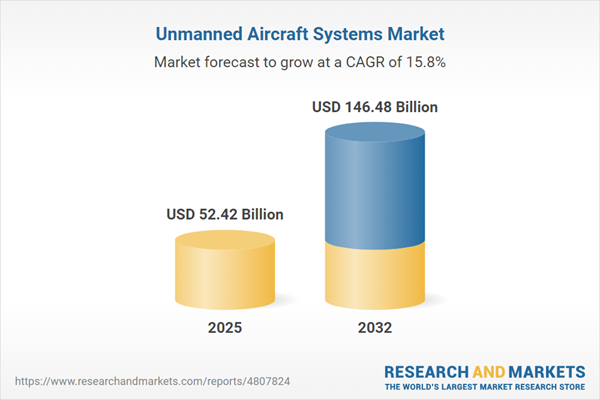Speak directly to the analyst to clarify any post sales queries you may have.
The unmanned aircraft systems market is evolving rapidly, driving operational advancements and delivering new efficiencies across industries worldwide. With expanding uses in diverse settings, organizations are increasingly turning to these systems to gain a competitive edge and address emerging challenges.
Market Snapshot: Unmanned Aircraft Systems Market Insight
The Unmanned Aircraft Systems (UAS) market grew from USD 45.18 billion in 2024 to USD 52.42 billion in 2025, and is expected to continue expanding at a compound annual growth rate of 15.83%, reaching USD 146.48 billion by 2032. This strong trajectory is driven by surging demand across defense, commercial, and public service sectors. Stakeholders are leveraging advancements in autonomy, sensor miniaturization, and connected platforms to unlock new applications and increase mission versatility. The market’s pace reflects intensifying investment, a dynamic regulatory landscape, and the necessity to adapt to evolving operational environments.
Scope & Segmentation of the Unmanned Aircraft Systems Market
This report provides strategic analysis across core segmentation areas, ensuring leaders gain actionable perspective on category trends and growth opportunities:
- Type: Fixed Wing, Hybrid, Rotary Wing
- Range: Long Range, Mid Range, Short Range
- Propulsion: Electric (Battery Electric, Fuel Cell Electric, Solar Electric), Fuel, Hybrid
- Altitude: High Altitude, Medium Altitude, Low Altitude
- Application: Aerial Photography & Cinematography, Agriculture, Defense & Security (including Electronic Warfare, Surveillance & Reconnaissance, Target Acquisition), Delivery & Logistics, Inspection & Monitoring, Mapping & Surveying, Research & Academia
- End User: Academic & Research, Commercial (such as Agricultural Services, Infrastructure Inspection, Logistics & Delivery, Media & Entertainment), Defense & Government, Public Safety
- Geographic Regions: Americas (United States, Canada, Mexico, Brazil, Argentina, Chile, Colombia, Peru), Europe, Middle East & Africa (United Kingdom, Germany, France, Russia, Italy, Spain, Netherlands, Sweden, Poland, Switzerland, United Arab Emirates, Saudi Arabia, Qatar, Turkey, Israel, South Africa, Nigeria, Egypt, Kenya), Asia-Pacific (China, India, Japan, Australia, South Korea, Indonesia, Thailand, Malaysia, Singapore, Taiwan)
- Technology Use: Focus on autonomous navigation, multi-domain integration, advanced sensors, AI-powered analytics, sustainability features, and resilient communication architectures
- Key Companies: SZ DJI Technology Co., Ltd; General Atomics Aeronautical Systems, Inc.; Northrop Grumman Corporation; The Boeing Company; Textron Systems Corporation; AeroVironment, Inc.; Israel Aerospace Industries Ltd.; Leonardo S.p.A.; Elbit Systems Ltd.; BAE Systems plc
Key Takeaways for Senior Decision-Makers
- Integration of autonomy and real-time analytics is reshaping workflows, reducing manual intervention, and enabling rapid mission adaptation across core industries.
- Organizations benefit from multi-domain UAS deployment by linking airborne, ground, and satellite assets for coordinated, scalable solutions in sectors such as agriculture, energy, and emergency response.
- Sustainability initiatives, including adoption of renewable propulsion and recyclable materials, are becoming critical to value propositions and vendor selection.
- Supply chain flexibility and the development of local partnerships are vital to manage exposure to tariffs, geopolitical volatility, and component shortages.
- Collaborative ecosystems involving both public and private sectors drive innovation, align regulatory frameworks, and open up new commercial and defense use cases.
- Competitive differentiation is increasingly defined by supply chain agility and the capacity to embed AI-driven autonomy and data connectivity into UAS offerings.
Tariff Impact on Unmanned Aircraft Systems Supply Chains
Recent tariff updates in the United States have amplified complexities within global UAS supply chains. Higher duties on core components such as composites and semiconductors have prompted manufacturers and vendors alike to diversify sources and invest in localized production, minimizing single-point dependencies and mitigating delivery risks. As procurement shifts toward assessing total cost of ownership, successful firms prioritize supplier agility and collaborative logistics models, reinforcing resilience amid evolving trade dynamics.
Methodology & Data Sources
This research combines direct interviews with market participants—including system integrators, authorities, and technology developers—with analysis of industry publications, government data, and technical journals. Data triangulation ensures accuracy, while periodic review panels validate interpretations against current industry standards.
Why This Report Matters
- Enables decision-makers to benchmark industry shifts, understand evolving technology use, and anticipate opportunities for sustainable growth.
- Offers actionable segmentation and supply chain insights to inform procurement, investment, and strategic alliances in critical UAS applications.
Conclusion
This report gives leadership teams concise, data-driven insights into unmanned aircraft systems and their transformative impact. An informed approach to technology adoption and partnership building will help shape resilient, forward-looking strategies.
Additional Product Information:
- Purchase of this report includes 1 year online access with quarterly updates.
- This report can be updated on request. Please contact our Customer Experience team using the Ask a Question widget on our website.
Table of Contents
3. Executive Summary
4. Market Overview
7. Cumulative Impact of Artificial Intelligence 2025
Companies Mentioned
The companies profiled in this Unmanned Aircraft Systems market report include:- SZ DJI Technology Co., Ltd
- General Atomics Aeronautical Systems, Inc.
- Northrop Grumman Corporation
- The Boeing Company
- Textron Systems Corporation
- AeroVironment, Inc.
- Israel Aerospace Industries Ltd.
- Leonardo S.p.A.
- Elbit Systems Ltd.
- BAE Systems plc
Table Information
| Report Attribute | Details |
|---|---|
| No. of Pages | 195 |
| Published | October 2025 |
| Forecast Period | 2025 - 2032 |
| Estimated Market Value ( USD | $ 52.42 Billion |
| Forecasted Market Value ( USD | $ 146.48 Billion |
| Compound Annual Growth Rate | 15.8% |
| Regions Covered | Global |
| No. of Companies Mentioned | 11 |









